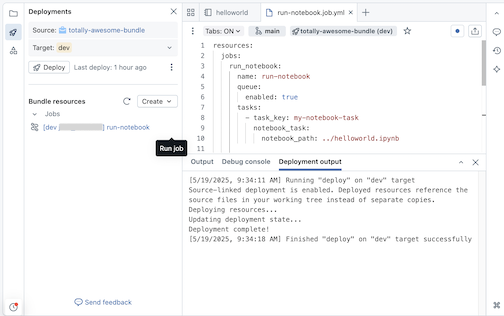Note
Access to this page requires authorization. You can try signing in or changing directories.
Access to this page requires authorization. You can try changing directories.
Important
Databricks Asset Bundles in the workspace is in Public Preview.
Assets that are part of your Databricks Asset Bundles can be created and modified from a local development environment or the workspace, but in order for the changes to be synchornized with the corresponding Databricks resources, bundles must be deployed. Bundles have unique identities in a workspace, so regardless of whether a bundle is deployed from a local machine or the workspace, bundle assets are not duplicated.
For requirements for using bundles in the workspace, see Databricks Asset Bundles in the workspace requirements.
For more information about bundles, see What are Databricks Asset Bundles?.
Deploy a bundle
To deploy a bundle from the workspace:
Navigate to the bundle in the workspace and click a bundle configuration YAML file, such as
databricks.yml.Click the deployments icon.
In the Deployments pane, choose a target workspace. Target workspaces are defined in the
targetsmapping of the bundle’sdatabricks.yml. See Databricks Asset Bundle deployment modes.
Click Deploy. The bundle is validated and details of the validation appear in a dialog.
Review the deployment details in this Deploy to dev confirmation dialog, then click Deploy.

Important
Deploying bundles and running bundle resources executes code as the current user. Make sure that you trust the code in the bundle, including YAML, which can contain configuration settings that run commands.
The status of the deployment is output to the Project output window. When the deployment completes, the deployed bundle resources are listed in the Bundle resources pane.
Source-linked deployments
By default, when you deploy a bundle to a development target through the workspace, resources created during deployment reference source files in the workspace instead of their workspace copies. File synchronization to ${workspace.file_path} is skipped. If you delete a bundle, only the resources defined in the bundle are deleted; the files remain.
To disable this behavior, in your bundle databricks.yml configuration file, set the source_linked_deployment deployment mode preset to false.
Important
Source-linked deployments are only applicable for Databricks Asset Bundles in the workspace. The source_linked_deployment preset is ignored if you deploy a bundle using the Databricks CLI databricks bundle deploy command.
targets:
# Disable source_linked_deployment in dev
dev:
mode: development
presets:
source_linked_deployment: false
For more information about deployment modes, see Databricks Asset Bundle deployment modes.
Run a workflow in a bundle
You can trigger a run of a resource defined in bundle after the bundle has been successfully deployed:
Navigate to the bundle in the workspace and click a bundle configuration YAML file, such as
databricks.yml.Click the deployments icon.

In the Bundle resources pane, click the run icon associated with any resource to run it.

Collaborate, review, and deploy to production
Databricks Asset Bundles in the workspace allows you to customize permissions to modify, deploy, and run the bundle for easy collaboration and troubleshooting. Databricks recommends collaborating on your bundle through Git, but for simple troubleshooting, you can share a bundle with your collaborators in the Databricks workspace. Navigate to the bundle project view and click Share. Bundles inherit the permissions of their parent Git folder, so sharing a bundle applies the changes to the parent Git folder.
When you have finished collaboration and testing of your bundle in dev, change the target deployment to prod to deploy to the current workspace.
Note
If a user does not have access to a production workspace they cannot deploy to that workspace. In addition, deploying bundles across different workspaces is not supported when you use the UI to deploy bundles.
Define a different production workspace for your automated deployments in the databricks.yml configuration file. See workspace.